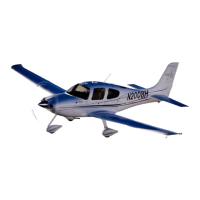
Do you have a question about the Cirrus DESIGN SR20 and is the answer not in the manual?
Presents a table of critical airspeeds (VNE, VNO, VO, VFE, VPD) with their KIAS, KCAS values and remarks.
Specifies maximum takeoff weight, maximum landing weight, and maximum baggage compartment loading.
Provides procedures for engine failure at altitude, emphasizing establishing best glide speed and identifying/correcting the cause.
Provides procedures for engine fires, cabin fires, and wing fires in flight.
Provides guidance on selecting a suitable field and preparing for a forced landing, including CAPS deployment considerations.
Explains when CAPS should be activated and the general actions to take.
Covers takeoff procedures, including mixture, power check, flap settings, and crosswind considerations.
Covers normal, short field, and crosswind landing procedures, emphasizing flap usage and touchdown techniques.
Lists stall speeds in KIAS and KCAS for different weights, CG locations, power conditions, bank angles, and flap settings.
Guides the pilot on calculating total weight and moment for loading, using forms and charts for proper operation within limits.
A form to calculate takeoff condition weight and moment by accounting for empty weight, occupants, baggage, and fuel.
A chart showing acceptable moment limits for various aircraft weights to ensure proper loading.
Explains the CAPS purpose, its potential risks, and the importance of pilot understanding.
Details brake fluid replenishment and inspection procedures, including temperature indicators.
Supplement describing the Artex ME406 ELT System, applicable for serial numbers 1005 and subsequent.
Explains the CAPS purpose, its potential risks, and the importance of pilot understanding.
